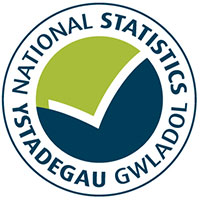Labour market data for UK countries and regions and also for local areas for 2020.
This is not the latest release in the series: Labour market statistics (Annual Population Survey)
The Annual Population Survey (APS) combines the boosted samples of the Labour Force Survey (LFS). It provides rolling four-quarter labour market data for UK countries and regions and also for local areas. For Wales, the APS consists of a sample of about 18,000 households every year.
The LFS remains the main source for headline labour market indicators at a Wales level. The larger sample of the APS allows for estimates at a local authority level and for sub-groups of the population’
The data for this period covers nine months of the coronavirus (COVID-19) pandemic as well as three months prior to the start of the pandemic, and therefore should be treated with caution. In the Labour market overview, we have included analysis on data sources that are giving more timely indications on how the pandemic is affecting the labour market in Wales.
APS responses are weighted to official population projections. As the current projections are 2018-based they are based on demographic trends that pre-date the COVID-19 pandemic. The Office for National Statistics are analysing the population totals used in the weighting process and intend to make adjustments where appropriate. Rates published from the APS remain robust; however, levels and changes in levels should be used with caution. This will particularly affect estimates for country of birth, nationality, ethnicity and disability. We have temporarily removed the section on protected characteristics in this headline until any necessary adjustments have been made. The latest data showed changes in employment for some groups that could be a result of the population weighting issue, and not reflect true changes. This data is still available on StatsWales.
Employment
- The employment rate for people aged 16 to 64 in Wales was 72.8%, down 0.3 percentage points on the previous year. The UK rate was 75.3%, down 0.4 percentage points over the year.
- Since 2001, the employment rate has increased by 5.7 percentage points in Wales and by 3.0 percentage points in the UK.
- The highest estimated employment rates were in Monmouthshire (80.0%), Flintshire (78.6%) and Newport (77.0%).
- The lowest estimated employment rates were in Merthyr Tydfil (65.8%), Rhondda Cynon Taf (67.3%) and Denbighshire (69.3%).
Unemployment
- The unemployment rate for people aged 16 and over in Wales was 3.7%, down 0.3 percentage points compared with the previous year. The UK rate was 4.5%, up 0.7 percentage points over the year.
- Since 2001, the unemployment rate has fallen by 1.8 percentage points in Wales and by 0.9 percentage points in the UK.
- The lowest estimated unemployment rates were in Carmarthenshire (2.3%), Pembrokeshire (2.5%) and Cardiff (2.6%).
- The highest estimated unemployment rates were in Merthyr Tydfil (7.5%), Caerphilly (5.6%) and Rhondda Cynon Taf (5.4%).
- Please note data for Neath Port Talbot and Bridgend have been suppressed due to inadequate sample size.
Youth unemployment
- The youth unemployment rate in Wales was 10.9%, below the UK rate of 13.3%.
- Since 2001, the youth unemployment rate fell 3.3 percentage points in Wales, but rose by 1.5 percentage points in the UK.
Long term unemployment
- 24.7% of unemployed people in Wales had been unemployed for 12 months or more. This compares with 20.2% in the UK.
Economic inactivity (excluding students)
- The economic inactivity rate for people aged 16 to 64 in Wales was 20.1%, up 0.2 percentage points compared with the previous year. The UK was 17.1%, down 0.3 percentage points over the year.
- Since 2001, the economic inactivity rate fell by 6.2 percentage points in Wales and by 4.3 percentage points in the UK.
- The lowest estimated economic inactivity rates were in Monmouthshire (13.6%), Vale of Glamorgan (16.1%) and Cardiff (16.4%).
Data
Datasets and interactive tools
Contact
Vanessa Allis
Telephone: 0300 025 9019
Email: economic.stats@gov.wales
Rydym yn croesawu galwadau a gohebiaeth yn Gymraeg / We welcome calls and correspondence in Welsh.

